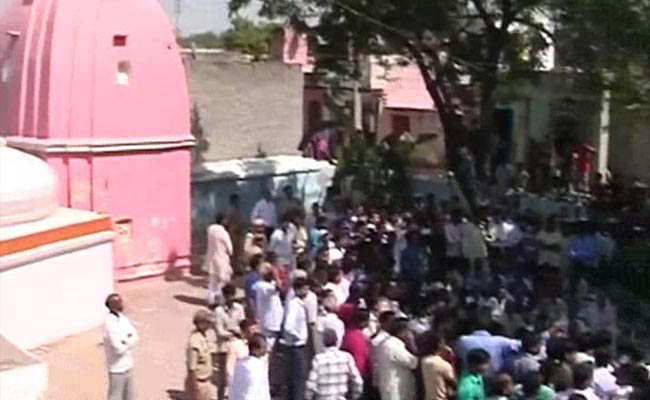Is Dadri the 'Muzaffarnagar' of the 2017 UP Polls?

NEW DELHI: The script is the same, the story a little different, the venue still in West Uttar Pradesh moving closer to Delhi, and the year 2016-2017 as against 2013-2014. But all indications are that the RSS front organisations have re-visited---or as local political leaders said, never really moved out of Dadri ever since a mob was mobilised last September to enter a poor man’s decrepit tenement, drag him out and beat him brutally to death.
A mahapanchayat was held in defiance of the state government and curfew orders. Vitriolic speeches were made attacking Mohammed Akhlaq’s family for allegedly consuming beef. The state authorities were given 20 days to arrest the relatives, and to release the 17 arrested last year for Akhlaqs murder. The tensions have touched new levels over night with the district administration unable to face the political assault, and the Chief Minister disappearing yet again behind the tattered shield of the bureaucracy.
In Dadri the pattern is now the same. Instead of love jihad, the issue here was on beef, the other potent instrument being used by the RSS front outfits to polarise and communalise the region. An announcement from a temple by unidentified youth that Mohammed Akhlaq and his family were eating beef led to a mob collecting outside the poor man’s tenement, dragging him and his son out, beating them mercilessly until Akhlaq died. His son was hospitalised for weeks with serious injuries. The terrified family had nowhere to go, and sought the state government’s help for their security and safety.
The national---and even international---outrage at the time prevented the Vishwa Hindu Parishad and other outfits that are now publicly active in Dadri from taking the issue further. At least in public. The forensic reports at the time said that the meat was mutton and not beef and the matter seemed to have subsided after a while, with even the initial reports of the family’s search for justice petering out.
The VHP and other little known outfits---as had been the case in Muzaffarnagar where new organisations had sprung up at the time of the violence----have reportedly remained busy in Dadri, away from the eye of the media and not so surprisingly the Samajwadi government that has demonstrated over and over again its inability to cope with the communal offensive. In Muzaffarnagar for instance Samajwadi party supremo Mulayam Singh Yadav told visiting opposition delegations that the bureaucracy was not cooperating and, that his son did not seem to know how to govern. A surprised MP told this writer at that time that Mulayam Singh spent the time passing off the blame on to his son whom he had insisted making chief minister.
The communal poison of Muzaffarnagar fed into the Lok Sabha 2014 elections with the BJP sweeping the state. All Opposition leaders spoken to from the Samajwadi party and the Congress in particular said that the BJP was clearly planning to use Dadri to step up the polarisation before the Assembly elections. And that Dadri has been selected as the target area for the state polls.
The similarities between Muzaffarnagar and Dadri are many:
- Muzaffarnagar town and adjoining villages went up in flames just before the Lok Sabha elections. The violence was preceded by an aggressive ‘love jihad’ campaign where the poison of hate was systematically spread through the hitherto peaceful villages where the Jats and Muslims were living and working together. The violence was fitted into the larger ‘love jihad’ campaign unleashed at the time by the RSS front organisations with rumours of eve teasing feeding into a communal orchestration that based itself on an altercation in which two boys were killed, a video found later to have been circulated by a BJP leader with false images, and a series of panchayat and mahapanchayat meetings that stoked the tensions further; Dadri tensions are being stoked by the anti beef campaign with the one deadly lynching striking fear across the state, and indeed the country. In western UP local leaders admit that they have found the minorities to be terrified, and fearful of their lives.
- In Muzaffarnagar and Dadri the attackers were known to the families attacked, being drawn from the same and adjoining villages. The first established a new trend in communal violence in the state, in that the assailants were neighbours and the second took it forward.
- It was one of those very rare occasions in UP that the communal violence moved from the town into the villages in Muzaffarnagar; in Dadri this was taken forward in that the violence started in a village. Incidentally both areas are close to Delhi, Dadri falling in Greater Noida.
- Muzaffarnagar set a new pattern in UP in that the deaths were relatively less, displacement of terrified Muslims huge. Entire villages were emptied out. In Dadri the same fear is now being generated with the few Muslim families looking for safety outside their villages.
- In Muzaffarnagar panchayats and mahapanchayats were held under the nose of the district administration where leaders made inflammatory speeches, inciting violence. In Dadri a similar mahapanchayat has been held with the same inflammatory speeches, but this time in defiance of the district administration and the Section 144 imposed in the area.
- In both Muzaffarnagar and Dadri the Akhilesh Yadav government has been reduced to a helpless (or as many in the Congress said complicit) bystander.
The open fear is that Dadri and the chaos it is clearly being prepped to generate will feed into the communal polarisation of the communities before the crucial Assembly elections. So far there has been no response worth its name from the Congress party, the Bahujan Samaj party or other political groupings like the Left.
(Photo:Mahapanchayat in Dadri in open defiance of prohibitory orders)



